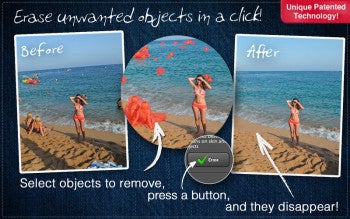 Snapheal sports an interface similar to that of Macphun's other Mac apps, Color Splash Studio ( Macworld rated 4 out of 5 mice ) and FX Photo Studio ( Macworld rated 3.5 out of 5 mice ), with the photo-editing area to the left and your editing tools to the right. The app is simple to use and easy to navigate, and features six editing tools: Erase; Clone and Stamp; Retouch; Adjust; Crop; and Rotate/Flip. (Even though erasing undesired objects from photos is the central feature, users can also perform basic image edits using Snapheal.)
Snapheal sports an interface similar to that of Macphun's other Mac apps, Color Splash Studio ( Macworld rated 4 out of 5 mice ) and FX Photo Studio ( Macworld rated 3.5 out of 5 mice ), with the photo-editing area to the left and your editing tools to the right. The app is simple to use and easy to navigate, and features six editing tools: Erase; Clone and Stamp; Retouch; Adjust; Crop; and Rotate/Flip. (Even though erasing undesired objects from photos is the central feature, users can also perform basic image edits using Snapheal.)We recently looked at Inpaint ( Macworld rated 3.5 out of 5 mice ), another Mac app that lets you remove objects from a photo. While Inpaint is less than half the cost of Snapheal, Inpaint is a one-trick pony--you paint over a selected area and click Erase. The only adjustment you can make is in brush size. Snapheal offers a bit more.
In my testing of Snapheal, the Erase tool worked fairly well, though better in less-cluttered and -busy shots. As with Inpaint, the process is as easy as painting over an object and then clicking the Erase button, but you can also make more-finely controlled edits. For example, you can adjust the brush diameter, unselect painted areas, and choose between three eraser modes: Wormhole, best for small imperfections and objects; Shapeshift, for big objects; and Twister, for sky shots and multiple small object. (I recommend experimenting to see which eraser mode works best--you can always undo an erasure you don't like. For instance, at times I preferred the Wormhole mode over the Twister mode for erasing an object from the sky, even though both did the job effectively.)

 Each of the erasing modes works as the app describes; the actual erase procedure (the most processor-intensive part of the process) happens quickly. And even if you're waiting for the app to erase a particularly large object, you'll be entertained by the Erase progress window, which displays fun facts such as, "There are more than 250,000 rivers in the United States, which amounts to more than 3.5 million miles of river." In general, Snapheal works well, although it isn't always perfect, as you can see in the image above--specifically, the desk corner just behind the removed object.
Each of the erasing modes works as the app describes; the actual erase procedure (the most processor-intensive part of the process) happens quickly. And even if you're waiting for the app to erase a particularly large object, you'll be entertained by the Erase progress window, which displays fun facts such as, "There are more than 250,000 rivers in the United States, which amounts to more than 3.5 million miles of river." In general, Snapheal works well, although it isn't always perfect, as you can see in the image above--specifically, the desk corner just behind the removed object.Once you're done erasing objects, you can perform simple edits right in the program. Snapheal's Retouch tab lets you selectively edit parts of an image for contrast, saturation, sharpness, blur, and brightness. You can make full-photo adjustments using the app's Adjust tool, which includes the same editing options as Retouch, as well as sliders for color temperature, hue, saturation, shadows, highlights, and noise. And a Clone and Stamp tool lets you can make fairly detailed fixes when Snapheal's erasures aren't perfect.
 Once you're finished, you can save your image to your computer, share it via email, or post it to Facebook, Tumblr, Flickr, or Twitter.
Once you're finished, you can save your image to your computer, share it via email, or post it to Facebook, Tumblr, Flickr, or Twitter.Macphun makes the weighty claim that Snapheal "can do magic." The app largely lives up to that claim, offering a simple way to remove objects from an image--you don't need to know anything about photo editing to know how to use Snapheal. If you have Photoshop, which includes a Content-Aware fill feature that accomplishes the same task, Snapheal is likely not for you. But for those who don't own Adobe's advanced--and wallet-denting--editing software, Snapheal is an excellent alternative.
Source 'http://www.pcworld.com/article/246495/snapheal_removes_unwanted_objects_from_photos_and_more.html'
www.timdatarecovery.com
info@takingitmobile.com
1-888-CALL-TIM
No comments:
Post a Comment
Note: Only a member of this blog may post a comment.